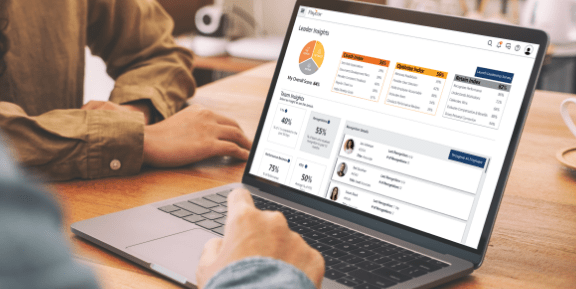Employee growth is a strategic imperative for companies that want to retain their workforce. When employees feel stagnant, they’re less engaged, less productive, and more likely to walk out the door. On the flip side, HR can boost retention, drive innovation, and cultivate a leadership pipeline by prioritizing professional development.
Goal setting is the first step. Whether you’re an HR leader looking to increase engagement or a manager who needs to develop your team, setting and implementing effective professional development goals can have a major impact. Use this resource to support employees, transform your workplace culture, and help your company’s bottom line.
What Are Professional Development Goals?
You can’t achieve success until you define it. Professional development goals are clear, specific achievements employees work toward as part of their larger career plan. The most effective goals align the employee’s strengths and interests with the company’s big-picture objectives. When each person’s individual career path contributes to the business’s success, everybody wins.
Why Is It Important to Set Development Goals for Work?
Without clear goals for professional development, career growth becomes a guessing game. Employees feel stuck, managers can’t make fair decisions, and your best people start looking elsewhere.
Employee Retention
The numbers tell the story: 67% of companies that champion career development are confident in their ability to retain top talent, compared to just 50% of those that don’t (LinkedIn Learning). By driving retention, professional development also slashes recruiting costs.
Employee Promotion
Development goals also solve the promotion problem. Instead of wondering “What do I need to do to get ahead?”, employees get a clear checklist. Managers can evaluate their work based on objective criteria, instead of playing favorites. This transparency builds trust and improves company culture.
When your employees’ growth directly supports the company’s long-term objectives, you’ve got yourself a succession plan. Your team gets stronger, skill gaps disappear, and you won’t be left scrambling to hire externally when opportunities arise.
How to Set Professional Development Goals for Work
Setting development goals is an intuitive process, but it’s important to start with a clear framework. Here’s how to create goals that stick:
Consider Company Objectives
Don’t set professional development goals in a vacuum. Look at where your company is headed—consider upcoming projects, strategic initiatives, market challenges, and C-suite objectives. The best development goals prepare employees for what’s coming up while advancing their careers. When individual growth supports business objectives, you’re investing in solutions, not just skills.
Assess Current Skills and Performance
Evaluate your employees as fairly as possible. Use performance reviews, skills assessments, and regular check-ins to identify strengths. These conversations give you valuable information on their personal goals and capabilities, while inviting them to share candid feedback. This practice promotes transparency and builds trust.
Identify Specific Growth Areas
Next, pinpoint exactly which skills your team needs to develop. Look at the gap between current skills and company needs—maybe it’s data analysis, leadership capabilities, or technical expertise.
Focus on 2-3 key areas rather than trying to fix everything at once. Employees who concentrate on specific areas of professional growth are 5 times more likely to achieve meaningful progress than those who scatter their efforts across too many goals.
Apply the SMART Framework
Match your company’s objectives with individual employee strengths and professional development goals. Apply the SMART framework here, ensuring each goal is:
- Specific
- Measurable
- Achievable
- Relevant
- Time-bound
For example, “improve business administration skills” is a good idea, but not a SMART goal. It could be replaced with a goal like “Complete advanced Excel certification within three months and reduce monthly reporting time by 20%.”
Create Actionable Development Plans
Break big goals into bite-sized steps. Identify training programs, mentorship opportunities, or stretch assignments that move the needle, helping employees grow at a sustainable pace. Ideally, employees should take an active role in designing their own development plans, with support from leaders.
Schedule Regular Check-ins
Monthly progress conversations keep employee development goals alive and relevant. These aren’t performance reviews—they’re coaching sessions that address obstacles and celebrate wins. Regular check-ins boost goal completion rates, strengthen professional relationships, and provide an added level of accountability for junior team members.
10 Examples of Professional Development Goals
Every person’s career development plan is unique, but these examples of employee development goals give you a starting point to support everyone on your team. Use this list as inspiration to learn how to write professional development goals that are customized for your team’s specific needs and company priorities:
1. Develop Leadership Skills
Help high-potential employees build the confidence to guide larger teams. This might include learning to delegate effectively, handle difficult conversations, or resolve workplace conflicts. Strong internal leaders reduce external hiring costs and maintain company culture during periods of growth.
Example: Lead one project by the end of Q2, delegating three major tasks and holding monthly one-on-ones with each team member.
2. Improve Public Speaking Abilities
Many talented employees avoid growth opportunities because they’re uncomfortable presenting. Help them practice with small groups first, then build up to executive presentations. Employees who can communicate ideas clearly become more valuable contributors and stronger candidates for advancement.
Example: Deliver four presentations over the next six months, starting with a 10-minute team update and building to a 30-minute executive presentation.
3. Strengthen Project Management Skills
Every department needs people who can organize resources, meet deadlines, and keep stakeholders informed. Start with basic planning and scheduling, then add budget management and team coordination skills. Because strong project managers improve efficiency across the entire organization, these kinds of employee development goals make an outsized impact.
Example: Complete a PM certification by the end of Q3. Manage two projects on time and within budget by year-end.
4. Expand Professional Networks
Networking is the process of building genuine relationships that create mutual opportunities. Encourage employees to join industry associations, attend conferences, or participate in online communities. Strong networks benefit both individual careers and company partnerships. HR can also help with this by creating opportunities where employees participate in professional development activities at work.
Example: Attend three industry events in 12 months and schedule quarterly meetings with five new professional connections.
5. Master New Software or Technology
Now more than ever, employees need to get comfortable with using new technology. Identify specific tools that could improve their efficiency or capabilities, then provide training and practice time.
Example: Achieve intermediate Salesforce proficiency within four months and build three custom reports that improve team efficiency by 15%.
6. Improve Time Management Skills
Poor time management increases stress and reduces the quality of employees’ work. Help team members identify productivity roadblocks, establish priorities, and develop sustainable work habits. Better time management benefits everyone.
Example: Reduce weekly overtime from 8 hours to 2 hours within three months by implementing time-blocking and prioritization techniques.
7. Improve Customer Service Skills
Every employee represents your company, whether they interact with customers, partners, colleagues, or job candidates. Focus on active listening, problem-solving, and maintaining professionalism under pressure. Excellent service skills benefit any role and create advancement opportunities.
Example: Increase customer satisfaction scores from 3.8 to 4.5 within six months by responding to all inquiries within 4 hours.
8. Enhance Research and Analysis Abilities
Good decisions require good information. Teach employees to evaluate sources, identify trends, and present findings clearly. Research skills help in strategic planning, competitive analysis, and identifying new opportunities.
Example: Complete two competitive analysis reports by the end of Q3, each using five reliable sources and presenting actionable insights to leadership.
9. Build Change Management Expertise
Change is constant, and organizations need leaders who can navigate it smoothly. Employees with change management skills set the tone for the future of the company and can guide their colleagues toward better outcomes. Focus on career development goals that help you hone communication strategies, address team resistance, and maintain productivity during uncertainty.
Example: Shadow a senior leader through two organizational transitions this year and document three lessons learned to apply in future initiatives.
10. Strengthen Emotional Intelligence
Technical skills get you hired, but emotional intelligence (or EQ) gets you promoted. Help employees recognize their own emotions, understand others’ perspectives, and manage relationships effectively. High EQ correlates with leadership success and team performance.
Example: Complete an EQ assessment and training within two months, then successfully mediate three team conflicts by the end of the fiscal year.
How to Achieve Employee Development Goals
Setting goals for work is the easy part. But helping employees actually achieve them requires ongoing support from management. It’s HR’s job to cultivate an environment where professional development goals turn into real results.
Accommodate Various Learning Styles
Leaders should provide access to resources that accommodate different learning styles. Some employees learn best through online courses, while others need hands-on workshops or mentorship programs. The key is presenting material in a way that resonates, empowering workers to learn new skills on their own terms.
Offer Practical Experience
Managers can also give employees stretch assignments, encouraging them to practice new skills in real-life situations. These opportunities provide hands-on experience while contributing to timely business objectives.
Track Progress Over Time
Most importantly, HR leaders and middle managers should track each employee’s progress over time. If they’re not improving—or not improving on the timeline you planned—you may need to adjust shared expectations. Make sure to include employees in any conversations about redesigning their development plan.
How Paycor Helps You Set and Measure Professional Goals
Paycor’s Talent Management Software provides comprehensive tools for creating, tracking, and achieving professional development goals. The platform connects to our career management software, providing clear pathways for advancement for everyone on your team.
Our Learning Management System delivers training content directly aligned with development goals, providing relevant resources exactly when needed. Finally, Paycor’s Pulse surveys gather continuous feedback on development experiences, helping HR leaders optimize programs and identify opportunities for improvement. This data-driven approach ensures development investments deliver maximum impact.
Achieve Your Development Goals by Using Paycor
Achieving successful employee professional development goals requires the right combination of empowering resources and systematic tracking. Paycor’s HCM platform provides all these elements in a single solution that simplifies administration while maximizing employee growth.
Ready to transform your approach to professional development? Request a guided product tour today!
Professional Development Goal FAQs
Want to learn more about employee development goals? Get the answers you need here.
What are SMART goals for professional development?
SMART goals for professional development are objectives that are Specific, Measurable, Achievable, Relevant, and Time-bound. For example, instead of “improve leadership skills,” a SMART goal would be “Complete leadership certification program and successfully mentor two junior team members within the next six months, as measured by their performance improvement and feedback scores.”
What’s the difference between personal and professional goals at work?
Personal development goals focus on individual growth that may or may not directly relate to current job responsibilities, like learning a new hobby or improving work-life balance. Professional development goals, on the other hand, specifically target skills gaps that enhance job performance.
What are some good employee development goals?
Good employee development goals could be: enhancing communication skills, developing technical expertise relevant to your role, building leadership capabilities, or improving project management skills.
The best goals align the individual employee’s career plan with the company’s key objectives, providing a clear pathway for career advancement.
How do I track my progress toward professional development goals?
You can track your progress through regular self-assessments, feedback from managers and colleagues, measurable outcomes like certifications earned or projects completed, and formal performance reviews. With a clear, specific, and time-bound plan for improvement, it should be easy to know whether you’re on track.
How often should professional development goals be set?
Individual professional development goals for work should be reviewed and updated at least biannually, typically during performance review cycles. However, many organizations benefit from quarterly check-ins. These meetings allow you to assess progress, adjust goals based on changing business needs, and set new objectives as previous ones are achieved. More frequent reviews ensure goals are relevant in the current business climate.









